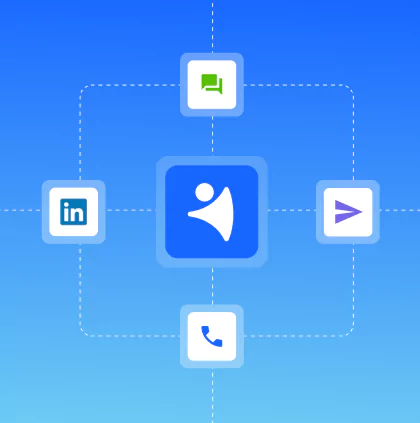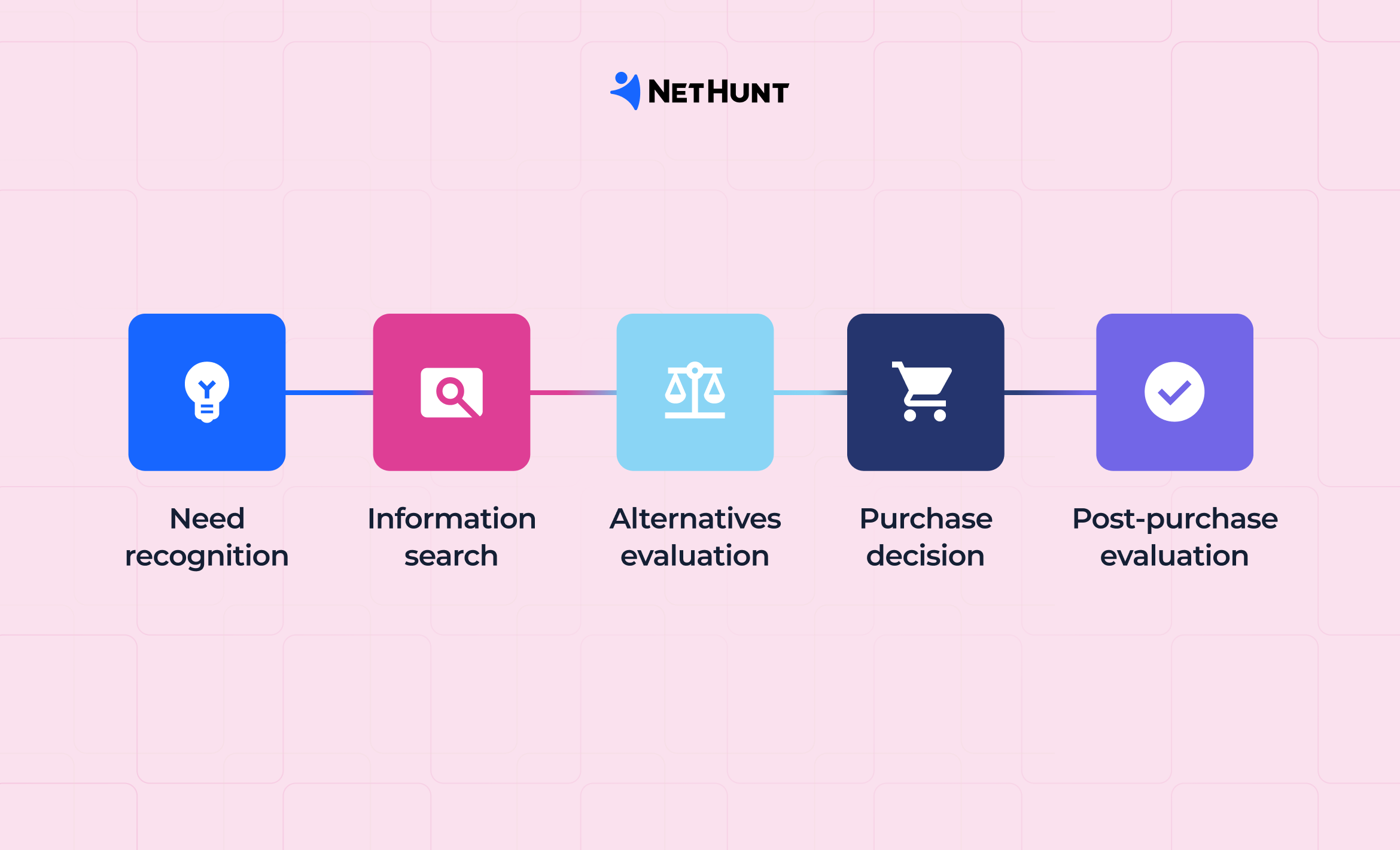Become an expert at turning prospects into lifelong customers.
Ever wondered what drives those late-night shoppers to scroll through reviews at 2AM and add items to their cart without a second thought? Well, this is the mystery of the consumer decision making process that every salesperson would love to understand. The good news is that once you learn the consumer decision making process steps, you’ll know how to turn prospects into loyal customers.
But seriously, how do consumers make purchasing decisions? Are there any stages? And if there are, what are the stages of the decision making process?
Well, no need to guess as this article already has all the answers for you. Learn the stages of the purchase decision process and how you can influence buying behavior with this knowledge.
What is the consumer decision making process and why it matters for your business
The consumer decision process is best defined as a series of steps a buyer takes to make a purchase decision. It’s not just a simple click or a quick swipe. A consumer decision process is a structured set of actions a buyer takes, consciously or unconsciously. And it doesn’t matter whether they want to purchase a perfect house or a daily essential - the steps would still be the same.
Let’s take a look at a consumer decision making model that conveniently breaks down the buying decision process into stages. By the way, this model is equally useful for sales and marketing teams, business owners, product developers, and customer experience teams. It tells you what drives a customer at each stage and points out moments where you can influence their decision.
So, the five major stages of the consumer buying decision process, in order, are:
- 1. Need recognition.
- 2. Product research.
- 3. Product comparison.
- 4. Customer purchase decision.
- 5. Post-purchase evaluation.
Now let’s dive deeper into what each stage of the consumer purchase decision process means.
The five stages of the consumer decision making process and their role in consumer behavior
If someone randomly listed the stages of decision making and asked you a question ‘Which of the following is the first stage of the buyer decision process?’ — what would you answer? You’d probably say, ‘Looking for the product’ aka ‘Product research.’
But in reality, for a customer to buy something, they have to acknowledge their NEED first. So, let’s talk about the first stage of the customer decision process - need acknowledgement or recognition.
Need recognition
When does the consumer decision process begin? Well, the buying process begins when consumers recognize a problem and the need for its solution. For instance, they might realize they’ve run out of product or that the product they already have is no longer meeting their needs. This could be anything from changing their cereal to buying a new house in a different state.
Can you impact the consumer decision process during the first stage? Sure, you can — with the use of wise marketing. And let us tell you how:
- Highlight problems customers may not realize they have. Engage with your audience through social media posts and marketing campaigns. Show customers how your product or service solves a problem they didn’t even know existed. For instance, a skincare brand might tell the audience about the hidden effects of daily pollution on skin, creating a need for their protective products.
- Create emotionally engaging content. We, human creatures, thrive on emotion. So, connect emotionally to your audience through storytelling, case studies, and testimonials. As an example, a wellness brand can create and share stories of their customers overcoming stress and anxiety with the use of their meditation app. Customer reviews and testimonials help you build trust as users would often trust customers more than the company itself during their consumer decision buying process.
- Offer free tools to uncover hidden needs like short quizzes or simple problem assessment tools. For example, a cybersecurity platform could offer a free online risk assessment so businesses can evaluate their digital security and take action before it’s too late.
- Create urgency with limited-time offers. Another rule of the consumer decision making process is that urgency creates action. Take Black Friday, for example. It is the pure definition of the shopping frenzy when retailers ignite anticipation among customers with doorbuster deals and flash sales. You can do the same with exclusive sales events or limited-time promotions to make customers skip a few stages of consumer decision making process and land directly in the purchase decision stage.
Congrats! Now you know that the first step in the buying decision-making process is to acknowledge a need or a problem that requires a solution.
Now, which stage in the consumer decision process comes immediately after need recognition? Let’s find out.
Product information search
The right answer to ‘What is the second stage of the consumer decision making process?’ would be ‘Product information search.’ During this stage of the purchase decision process, a customer has already recognized their problem and is looking for a solution.
They read online reviews, browse product comparisons, and consult friends or social media for recommendations. That’s why you should be a trustworthy source of knowledge during this stage. For you, in the business buying decision process, what comes after problem recognition is ensuring that potential customers can easily access the information they need. At the same time, your customers should see that you understand their pain points and are there to help them.
This is how to impact your customer decision making during the product research stage:
- Be a knowledge hub for your customers. Offer detailed product descriptions, comparisons, and FAQs that address common concerns. Let’s say you’re a software company. In this case, you can create a dedicated resource center with in-depth guides, user manuals, and comparison charts showing how your product stacks up against competitors.
- Let the customers who already trust you speak. Authentic feedback creates trust and makes prospects feel connected to your brand. Encourage customers who have already purchased your services or product to leave reviews and post-purchase opinions on your website or social media.
- Visualize success with compelling videos and images of your product or services. Infographics, videos, and high-quality images simplify complex information and help customers grasp how your product can solve their problem faster.
- Become a trusted social media ally. What is the channel where your audience spends most of their time? Instagram? For instance, a fitness brand might host live Q&A sessions on Instagram to address common questions and concerns about their products. Answer questions, participate in discussions, and share helpful content to build your reputation as a go-to resource.
Now let’s move to the third stage of the purchase decision making process.
Product comparison and evaluation
Don’t be naive — a customer already has a criteria of what they want to buy and you can’t guess what’s on that secret list. That’s unfortunate, right? And there is also a hidden danger — a customer might switch to your competitor if they see that your product or service can’t meet their needs.
Expect that your potential customer would weigh options, analyze product features, and look for the best value for their investment in the long term.
So, stop thinking, ‘What is the correct order of the five stages in the buyer decision process?’ And focus on how to retain your customers instead (yes, that’s totally possible):
- Create transparent comparison guides. Make easy-to-read comparison charts that outline your product’s features alongside those of competitors. Or partner with influencers in your industry to create product review videos.
- Showcase unique selling points. Highlight what makes your product unique. Are you a skincare brand? Then emphasize your use of organic ingredients and cruelty-free practices.
- Use the magic of side-by-side testing. Let your customers choose by trying out your products for free. For instance, a kitchen appliance brand might offer a cooking class or demonstration where customers can use their blenders or mixers alongside other popular brands.
- Sometimes, it’s all about the entertainment. Let your customers explore your products in a fun way. For instance, if you’re a furniture retailer, you could develop a virtual room planner that helps customers visualize how your products fit into their spaces.
Now let’s move to the pinnacle of the consumer decision making process - the purchase decision.
Purchase decision
Once a customer weighed all their product options, they’d make a decision (and hopefully choose your product ?). This is a crucial moment in the user journey map, where all your efforts to inform, engage, and build trust come together.
You can still take the following steps to ensure a customer chooses your product:
- Offer clear calls to action. Keep your calls to action straightforward. For instance, a clothing retailer might use buttons like “Shop Now” or “Get 20% Off Your First Order” to encourage immediate action.
- Simplify the checkout process. Remember Amazon’s one-click ordering system? Yes, that is the beauty of simplicity in the consumer purchasing process. Your customer purchasing experience should be as short as possible. For instance, let your customers make purchases without registering an account. Offer multiple payment options and provide a clear progress indicator.
- Customers love transparent pricing from the very beginning. And they hate surprises at the checkout. That’s why we advise you to stay clear about shipping and taxes throughout the entire buying process.
- Confidence comes with guarantees. Offer money-back guarantees or free returns to reassure customers. This is the way to show customers that you stand behind your product and care about their satisfaction.
- Again, create a sense of urgency. Display how many people are currently viewing or have purchased a product. For example, an online booking site might show that a hotel is “almost fully booked” to encourage quick decisions.
- Use the power of customer support. Ensure your customers have easy access to real-time support. Offer multiple communication channels, such as live chat, email, meeting recording platform, or phone, so they can resolve issues quickly.
Wait, this is not the end. You might think that ‘Purchase decision’ is the right answer to ‘What is the last step in the consumer decision-making process?’ Surprise-surprise — it’s not! Let’s find out why the purchase decision isn’t the last stage in the buyer decision making process.
Post-purchase evaluation
Your customer journey doesn’t end with the delivery guy leaving the product on their doorstep. What is post-purchase evaluation and why is it so crucial? Post-purchase evaluation is one of the buyer decision process steps when customers assess their satisfaction with the product and the purchase process in general. Will they buy from you again? Well, everything depends on the conclusion they make.
So, can you make your customers stay loyal to your brand? Yes, you can.
- Send a heartfelt follow-up. A simple thank-you email can go a long way! Show your customers that you value their opinion and invite them to share their feedback and leave post-purchase reviews.
- Offer helpful resources. Provide easy access to tutorials, guides, or FAQs to help customers get the most out of their new purchase.
- Reward customer loyalty. There’s no better way to make your customers feel appreciated and eager to return than by offering an enticing loyalty program that rewards repeat customers.
- Be there when they need you. Want to reinforce your customer’s trust in the brand? Ensure your customer support is ready to address any questions or concerns promptly.
Now you know the secrets to influencing your customers when it comes to making decisions. That’s great, but it’s only half the battle. In the marketing decision making process, you need to back up your sales strategy with the right tech stack. After all, managing customer interactions and ensuring timely follow-ups can be a challenge without the right tools in place. This is where a CRM system like NetHunt hits the mark. Let us tell you exactly how.
How to manage customer’s journey in NetHunt CRM and impact the buying decision process
From the moment a customer recognizes their need, NetHunt CRM ensures you’ve got all the tools at your fingertips for the efficient management of the decision making process in marketing.
Capture quality leads without breaking a sweat
What is the first step in the basic consumer decision process? Right, the need recognition. After that, a customer would readily dive into product research. Once they visit your website, social media, or any other communication channel, NetHunt CRM will capture their data so you can effortlessly create a record right within your Gmail inbox.
No more switching between platforms, wondering how to find the decision-maker in a company. NetHunt CRM scrapes all publicly available information about your prospect and helps you fill your database with leads in a click.
Nurture leads with smart automation
Automations in NetHunt CRM allow you to trigger messages based on customer behavior. Are they stuck in the purchase decision stage? Automate a friendly follow-up or discount email to tip the scales in your favor. Has a customer filled their cart but left it? Send them a personalized offer through their favorite communication channel to move them along the funnel.
As you can see, NetHunt CRM assists customers throughout their entire consumer decision making journey.
One more thing. Which is the final decision stage of the purchase decision process? In case you forgot, it’s the post-evaluation stage when a customer decides whether they are satisfied with their buying experience or not. With NetHunt CRM, you can send follow-up emails to encourage your customers to leave reviews, address their concerns, and inform them about new products or discounts, all tailored to their preferences.
Get a clear picture of your sales pipeline
NetHunt CRM's customizable sales pipeline gives you a visual overview of where each deal stands and helps you spot where leads are stalling. The system also sends notifications when leads advance, ensuring you’re always on top of the game.
Keep your customer data organized
NetHunt CRM offers custom fields, timelines, and tags. As a result, you get a bird’s-eye view of every interaction with each customer. Whether it's tracking post-purchase feedback or following up on a specific offer, you can easily pull up the entire history of your relationship with a client in a single place.
This is how NetHunt CRM helps customers decide on your product:
- Native Gmail integration. Work where you already do — your inbox. No need to onboard a new platform! NetHunt lives inside Gmail — it gives you the power of CRM without ever leaving your email tab.
- Automation that works for you. Automate follow-ups, assign tasks, and nurture leads—all without lifting a finger.
- Ultracustomizable sales pipelines. Visualize your deals from start to finish and impact your customer behavior during all the consumer decision process steps.
- Segmentation and tagging features. For highly personalized customer engagement, leverage advanced segmentation and tagging features to categorize your contacts based on behavior, preferences, and demographics.
- Configurable workflows. Design a CRM experience that aligns perfectly with your operational needs. For instance, set up a workflow that triggers onboarding materials immediately after a sale, or automate reminders for follow-up tasks based on customer interactions.
This is how pricing influences the consumer buying process
The pricing of the entire buying experience influences the customer's decision to buy or not. Consider this: what if you have the same price as your competitor but, unlike them, also offer free shipping? Even this tiny difference can impact consumer perception and make them choose your product over others.
When done right, pricing can set you apart in a crowded market and make your product or services more attractive compared to competitors.
So, the question is: how to understand and strategically manage your pricing for increased sales and customer loyalty? We’ve got some ideas.
- Analyze competitors. Regularly review your competitors' pricing and offerings. Take note of any promotions or changes they implement to find out how you can enhance your own pricing strategy.
- Communicate value. Make the value of your product or service clear and straightforward. Focus on the benefits that make it worth the price, such as quality, durability, or exceptional customer support.
- Set transparent pricing structures. The consumer decision making process begins with trust. Customers dislike hidden fees, especially after they’ve gone through the main stages of consumer buying process and chose your product.
- Test pricing models. Experiment with various pricing models (tiered pricing, subscription plans, bundled deals, etc.) to find what resonates best with your audience. Use sales reporting in CRM systems like NetHunt CRM to analyze sales data and find out which models lead to higher conversions.
- Honest customer feedback matters. Use surveys and interviews to gain insights into how customers perceive your prices.
Bottom line
Let’s recap what you’ve learnt. There are five stages in the consumer purchase decision process. The first stage is need recognition where a customer recognizes their need to purchase a product or a service. Next comes the information search when a customer looks for solutions aka products/services. Then they move to product comparison and finally arrive at the purchase decision, followed by post-purchase evaluation. And that’s their purchase decision process in short.
Now that you know the 5 stages of consumer decision making process, what’s next? It’s time to empower your sales processes and hit the ground running with a CRM system like NetHunt! Track customers at every stage, automate follow-ups, and nurture prospects like a pro — your journey starts now.
FAQ
How do consumers determine whether a purchase is a good deal?
Consumers evaluate if a purchase is a good deal by comparing prices, reading reviews, and assessing the value offered. They often look for sales or discounts and consider their budget to ensure they’re making a smart financial choice.
What stage in the consumer decision process follows need recognition?
The stage that follows need recognition is the product information search. After realizing they have a need, consumers actively seek out information about potential solutions, products, or services that can fulfill that need.
What is the second step in the consumer decision-making process?
The second stage of the consumer decision-making process is product information search. This is when consumers gather information about available options, comparing different products, brands, and prices to make an informed decision.






















 product experts — let's find the best setup for your team
product experts — let's find the best setup for your team